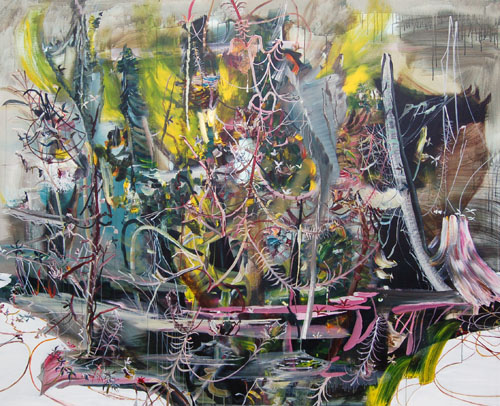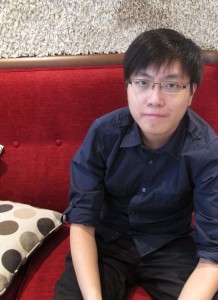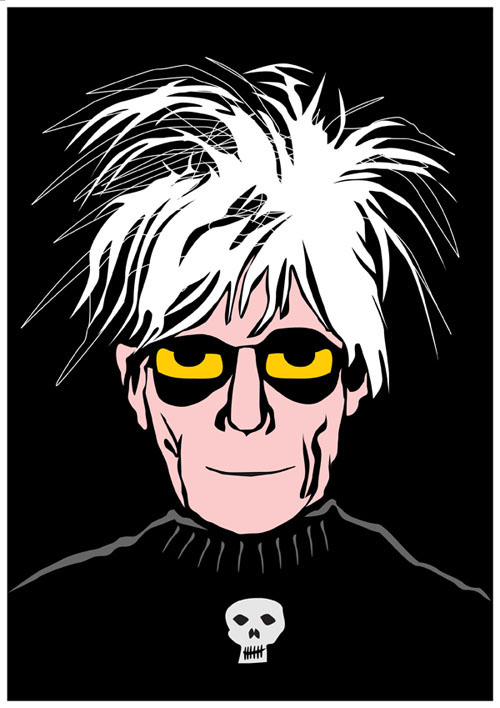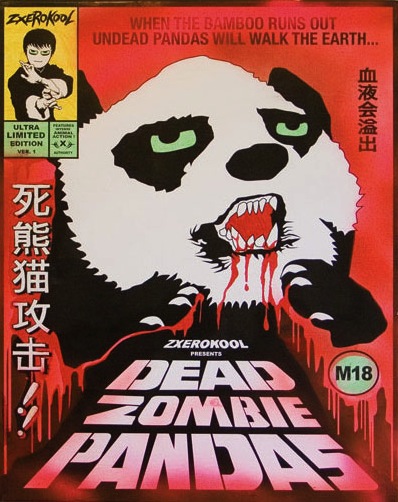Guest blogger Luise Guest encounters intergalactic ninja on her Singaporean adventures…
Singapore has been endeavouring to position itself as a cultural hub of the Asia Pacific for some time now, with mixed success. In an attempt to move away from its image as a somewhat sterile shopping destination, the government and arts institutions have emphasised the arts and contemporary design. I have always thought Singapore was far more interesting than the cliché of the shopping stopover, with its fascinating hybridity of culture and language – the original ‘fusion’ metropolis.
On previous visits I have been impressed by the shifts away from sterility and tight control, towards a recognition of the exciting possibilities of contemporary art. The new wing of the Singapore Art Museum, SAM at 8Q, has shown some really interesting installation work by young Singaporean artists, as well as exhibitions from Japan and Korea. The Substation on Armenian Street has long been at the centre of innovation in both visual and performing arts and has shown work which is genuinely experimental and interesting. So, despite the continuing debates about freedom of expression, there have been indications that artists were increasingly able to practice unfettered, at least to some extent, by political repression. Some commentators have suggested that a greater threat to the arts in Singapore is the emphasis on wealth and commerce in a culture that prefers the status of the foreign import to the home-brand, whether designer labels, theatre productions or artworks.
Indeed, on my most recent visit two weeks ago, by and large the commercial galleries were showing work by Mainland Chinese artists (obviously now the most acceptable international contemporary art ‘brand’). The most heavily advertised art exhibition was the French Modern Masters show in the gallery space of the new Ion Orchard mega mall. This is 8,000 square feet of space in the middle of the consumerist Mecca of Orchard Road, in a new mall which seemed to me, as I vainly searched for an exit, reminiscent of the old ‘Roach Motels’ – “they can check in, but they can’t check out!” Their web site advises that “their friendly and professional team will be happy to offer any assistance and advice” – presumably should you wish to purchase a Picasso or a Bonnard to go with your Louis Vuitton and your Prada. The other artistic option advertised for tourists was Salvador Dali at the new Marina Bay Sands resort for the uber-wealthy. Somewhat disheartened, I continued to look for some actual contemporary art.
I had to search diligently to seek out evidence of a lively local art scene: it is there, and it is interesting, and very particularly Singaporean, but to the outside observer it seems to lack the energy and optimism of a few years ago. I met with the young artist/designer/’intergalactic ninja’ Jonathan Leong (aka Zxerokool), enjoyed Justin Lee’s tongue-in-cheek installation at the entry to those ubiquitous Entombed Warriors at the Asian Civilisations Museum (can there be anyone left in the developed world who has not yet seen them?), and saw two or three shows which provided evidence that contemporary art practice is alive and well, albeit a little hard to find.
Ian Woo, We Have Crossed the Lake, Acrylic on Linen, 194cm x 244cm, 2009. Image reproduced courtesy of the artist.
Abstract painter Ian Woo’s review show at the Institute of Contemporary Art, Lasalle College of Fine Arts, is impressive. Lyrical and beautiful, without ever descending into empty gesture, or becoming formulaic, Woo’s body of work reveals a practice of unremitting commitment and a single-minded examination of the possibilities of colour, mark and surface. Owing a debt to Philip Guston and Susan Rothenberg, as well as to canonical abstract painters of the mid-20th century such as Kline or Motherwell, the works represent nevertheless a powerful and idiosyncratic visual language all his own. In works such as ‘We Have Crossed the Lake’, 2009, the figure-ground relationships demonstrate a confident knowledge that what is left out is just as important as what is shown. An energetic calligraphy of white and black lines scrawls with apparent abandon across the surface of the work, yet underlying the gestural mark-making is a sure, spare restraint which derives from his evident knowledge of Chinese ink-painting traditions.
Playing with hard edge shapes versus lyrical, smoky drifts of grey and ochre, an earlier work such as Before I give an answer I see a flower indicates more obviously the artist’s influence from New York painters such as Guston. The ethereal drawn lines of The Clearest Symbol, dating from 1997, tantalise with hints of mysterious half-seen objects or landscapes. The subtlety of the grey washes and stains and the spare restraint of the floating forms evoke a dream-like state. Large ink drawings in this show reinforced this sense of meditation – a surprising calm as many of the individual works are so filled with energy and crammed with disparate shapes, colours and forms. Woo has said he is interested in complication, confusion and connection, and this sense that the artist is working out difficult problems on the surface of each painting is a thread running through this show.
Ian Woo, Before I give an answer I see a flower, oil on canvas, 200cm x 180 cm, 1995. Image reproduced courtesy of the artist.
A much younger artist is Jonathan Leong, who also goes by the name of ‘Zxerokool’ and describes himself as a practitioner of ‘visual kungfu and creative mayhem’.
We meet for coffee in the lovely leafy surrounds of Ann Siang Street, with its restored shophouses now home to design studios, advertising agencies and ‘consultants’ of every possible variety. Our conversation ranged across his own art practice to his simultaneous work as a designer and art director, known for his ability to bring Gen Y street cred, and a distinct visual style to projects for brands such as New Balance, Feiyue, Tiger Beer, Nike and MTV – brands aiming to target younger consumers and swim in that desirable pool of social media savvy, international, ‘life-style’ corporate identities.
At 28 looking almost absurdly young (and making me feel, oh, so very old) he talks enthusiastically about his digital media, graphic design and sculptural projects, and especially about his first solo show next year in New York at the very, very groovy Reed Space on the Lower East Side, entitled ‘When the World Ends, and Other Strange Tales‘. This year he has shown with Martin Kemble’s Art Labor Gallery in Shanghai, as well as in a group show at Chan Hampe @ Tanjong Pagar in Singapore. As we talk I can’t help but imagine Jonathan as a young boy, immersed in the world of video games and sci-fi fantasy, in a computer-generated world of his own design.
Jonathan Leong, aka Zxerokool, photographed by Luise Guest and reproduced with the permission of the artist.
Coming as he does from a highly pragmatic Chinese family, he tells me that romantic archetypes of the artist as a genius starving for his art would cut no ice at all, and that claims of ‘tension’ between the two aspects of his creative identity would be a luxury he cannot afford. In fact, he says, “I believe that art and commerce can coexist, sometimes very effectively. Everything is cross-over now”.
In Singapore cutting-edge design, architecture and marketing are highly influential and visible everywhere, so this new kind of artist identity is highly appropriate to this place, and this time. His artistic hero is, no prizes for guessing, the original cool inhabitant of that cross-over and unashamedly commercial realm, Andy Warhol. In the exhibition ‘100 friends’, Singaporean artists were invited to draw the artist who most influenced them, and Jonathan had no hesitation in selecting the ubiquitous Andy as his subject. In this show, 100 A4 framed artworks by 100 artists were priced at S$199 on a cash and carry basis with 100% of the proceeds going to the TRANSMISSION: PROJECT, an annual experimental ‘incubatory platform’ for young artists and designers to come together in an artistic exchange and mentoring process.
Xzerokool (Jonathan Leong), ‘The Master of Pop’, digital graphics, image reproduced courtesy of the artist
Leong identifies the significant Singaporean Phunk Design Studio as a major influence on his work (and, I would guess, on his artistic identity). They have been described as propagating a visual signature that blends and recontextualises influences as diverse as traditional Chinese art, craft, philosophy and culture, Hong Kong wuxia, Japanese manga and otaku subcultures, together with Western popular culture, art and design movements. Highly influential in the Asian design world, they aim to challenge conventions of the separation of artist and designer by deliberately and playfully blurring the boundaries.
Xzerokool (Jonathan Leong), Dead Zombie Pandas, digital graphics, from the ‘fake comic book cover’ series, image reproduced with permission of the artist.
As a young artist, one of the first generation to experience the transition from slow to fast broadband internet access, and able to move seamlessly between all the various forms of social media, Leong describes the way that people now ‘curate’ their own identities. This suggests once more that previous ideas of the fixed role of ‘the artist’ are somewhat outmoded. Notions of the true artist being somehow sullied by a dalliance with commerce now appear so quaintly 20th century that they might belong in the Madison Avenue offices of Mad Men. He says his work is inspired by science fiction, architecture, contemporary visual culture and ‘the moments in between dreams and reality.’ In exploring themes of urban utopia and fantasy he has created his popular and highly engaging series of ‘fake comic book covers’. Currently a little obsessed with the resurgence of zombies in popular culture; he is also planning to design some ‘info-graphix’ parodies for his show in New York, which will include a zombie-proof house. Why? Because, he tells me, the current popular culture zombie obsession indicates a deeper unease, a feeling that everyone is looking for a safe place. Of course the irony is, “One is never really safe in a time of chaos”.
The juxtaposition of an artist such as Ian Woo, working within the ‘high art’ conventions of painterly abstraction, with a young, entrepreneurial ‘mash-up’ practitioner such as Leong, may seem bizarre. However, Woo has been commissioned to design artworks for one of the newly opened MRT stations, at Harbour Front, for which he has produced abstract, monochrome, architecturally inspired graphic works. One very strong element in the Singaporean art scene is an interest in design in all its forms, and the breaking down of barriers between artists, architects and graphic designers in particular. The Red Dot Design Museum has a steady stream of Singaporean visitors examining iconic design products, and the work of young artists such as Zxerokool, Erica Lai, Joey Soh and Miguel Chew, as well as established figures such as Justin Lee, demonstrate the successful hybridisation of art and design.
In a city such as Singapore, with its increasingly futurist utopian skyline dominated by what some see as the sinister submarine-like shape of the top of the Marina Bay Sands towers, this savvy combination of commerce with art practice reflects the mercantile history of the Chinese and Peranakan inhabitants as well as its position in the global marketplace. Chaos abounds, as even the most casual glance at the Straits Times will tell you, but there is always room for a little tongue-in-cheek zombie-proofing, and a playful approach to the serious business of art.
Luise Guest is a Sydney based art teacher and blogger who has been writing about Chinese contemporary art since her trip to China early in 2011 on a NSW Premier’s research scholarship. Spending time in Beijing, Shanghai, Guangzhou and Hong Kong she met and interviewed more than 20 artists, curators, academics and art writers. She is now an obsessive Sinophile attempting to learn Mandarin and impatiently planning future trips to China. Her interests extend to the broader spectrum of contemporary art in the Asia Pacific region. Her blog: www.anartteacherinchina.blogspot.com





